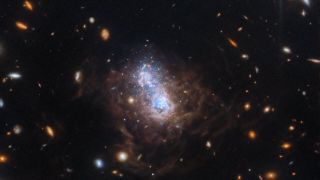
The dwarf irregular galaxy I Zwicky 18 lies at the center of this image. The bright region of white and blue stars at the galaxy’s core appear as two distinct lobes, representing different periods of star formation.
(Image credit: ESA/Webb, NASA, CSA, A. Hirschauer, M. Meixner et al.)
A small galaxy bursts with star formation in a dazzling new image from the James Webb Space Telescope.
The galaxy, called I Zwicky 18 (I Zw 18), is located roughly 59 million light-years from Earth. It is classified as a dwarf irregular galaxy, meaning it’s much smaller and less structured than our Milky Way galaxy.
The James Webb Space Telescope’s Observations of I Zw 18 suggest the galaxy has gone through several sudden bursts of star formation, creating two distinctly bright regions of white and blue stars at its core.
Related: Marvel at the James Webb Space Telescope’s largest image of the cosmos yet
Wispy brown filaments surround the central starburst region in the new JWST photo. These filaments represent bubbles of gas that have been heated by stellar winds and intense ultraviolet radiation unleashed by hot, young stars, according to a statement from the European Space Agency.
Previous Hubble Space Telescope observations of I Zw 18 revealed fainter, older red stars within the galaxy, suggesting its star formation started at least one billion years ago — possibly as much as 10 billion years ago. While the JWST’s observations previously capture dusty and evolved stars, the new image also shows signs of more recent star formation, possibly triggered by an interaction with a neighboring companion galaxy — the hazy blue region located just below the dwarf galaxy in the new image.
“Webb’s new data suggest that the dominant bursts of star formation in these regions occurred at different times,” ESA officials said in the statement. “The strongest starburst activity is now believed to have happened more recently in the northwest lobe as compared to the galaxy’s southeast lobe. This is based on the relative populations of younger versus older stars found in each of the lobes.”
Breaking space news, the latest updates on rocket launches, skywatching events and more!
The recent image, which was released on March 26, was taken as part of an initiative to study the life cycle of dust in I Zw 18. Building on the observations taken by Hubble at optical wavelengths, the JWST is able to study the dwarf galaxy in greater detail at infrared wavelengths.
“This galaxy is of particular interest as its content of elements heavier than helium is one of the lowest of all known galaxies in the local universe,” ESA officials said in the statement. “Such conditions are thought to be similar to those in some of the first star-forming galaxies at high redshift, so the Webb study of I Zw 18 should shed light on the life-cycle of stars and dust in the early universe.”
Join our Space Forums to keep talking space on the latest missions, night sky and more! And if you have a news tip, correction or comment, let us know at: community@space.com.
Samantha Mathewson joined Space.com as an intern in the summer of 2016. She received a B.A. in Journalism and Environmental Science at the University of New Haven, in Connecticut. Previously, her work has been published in Nature World News. When not writing or reading about science, Samantha enjoys traveling to new places and taking photos! You can follow her on Twitter @Sam_Ashley13.
>>> Read full article>>>
Copyright for syndicated content belongs to the linked Source : Space.com – https://www.space.com/james-webb-space-telescope-galaxy-zwicky-18
